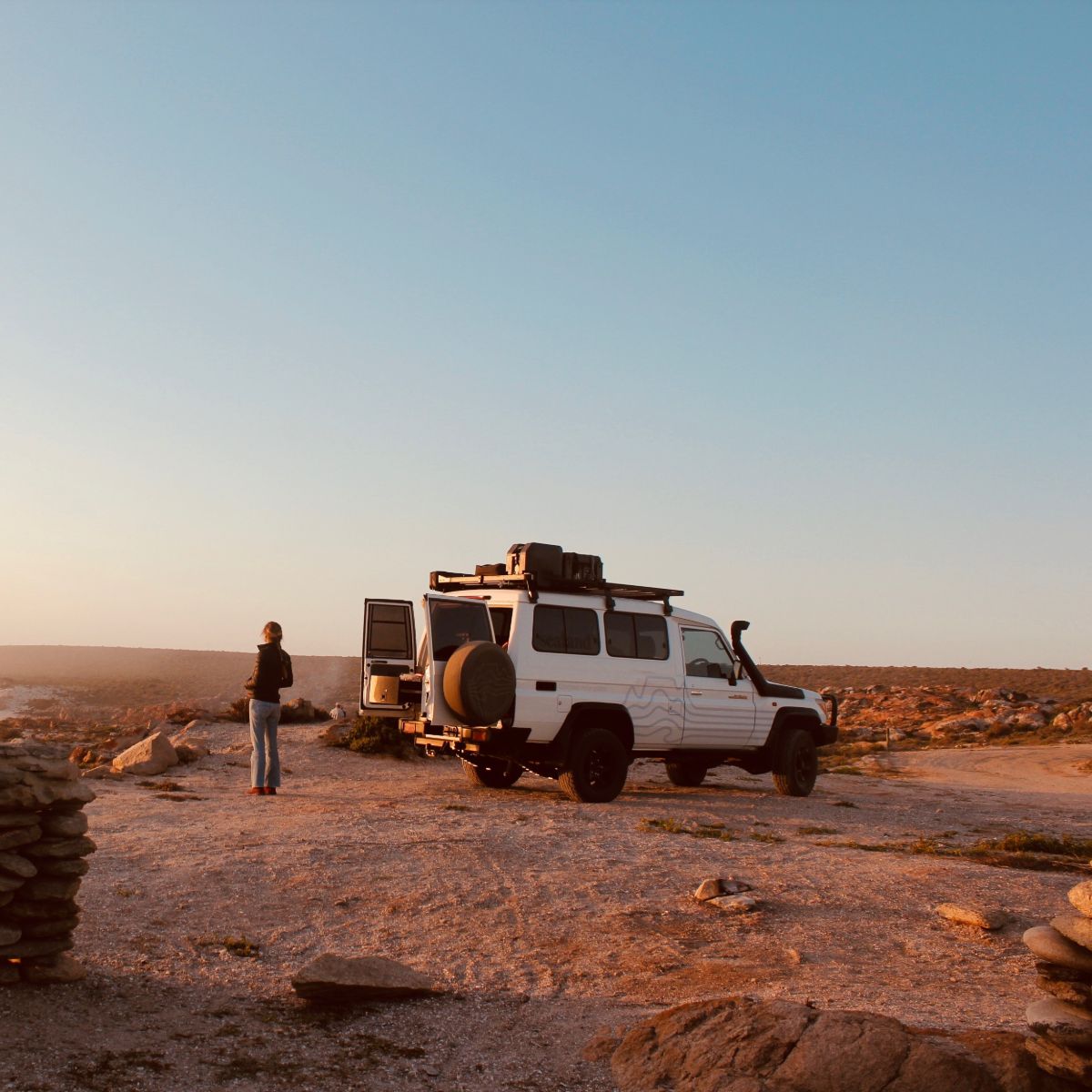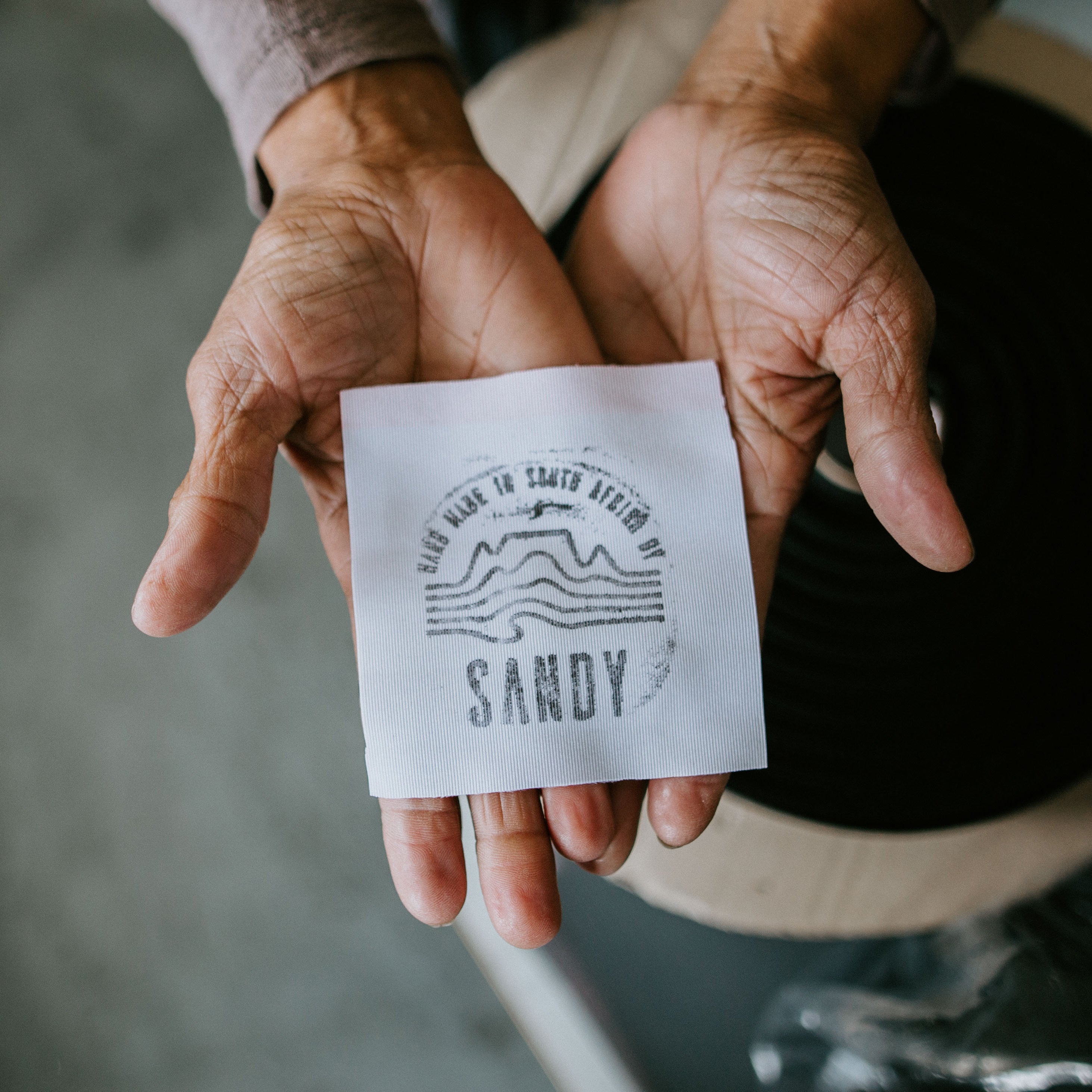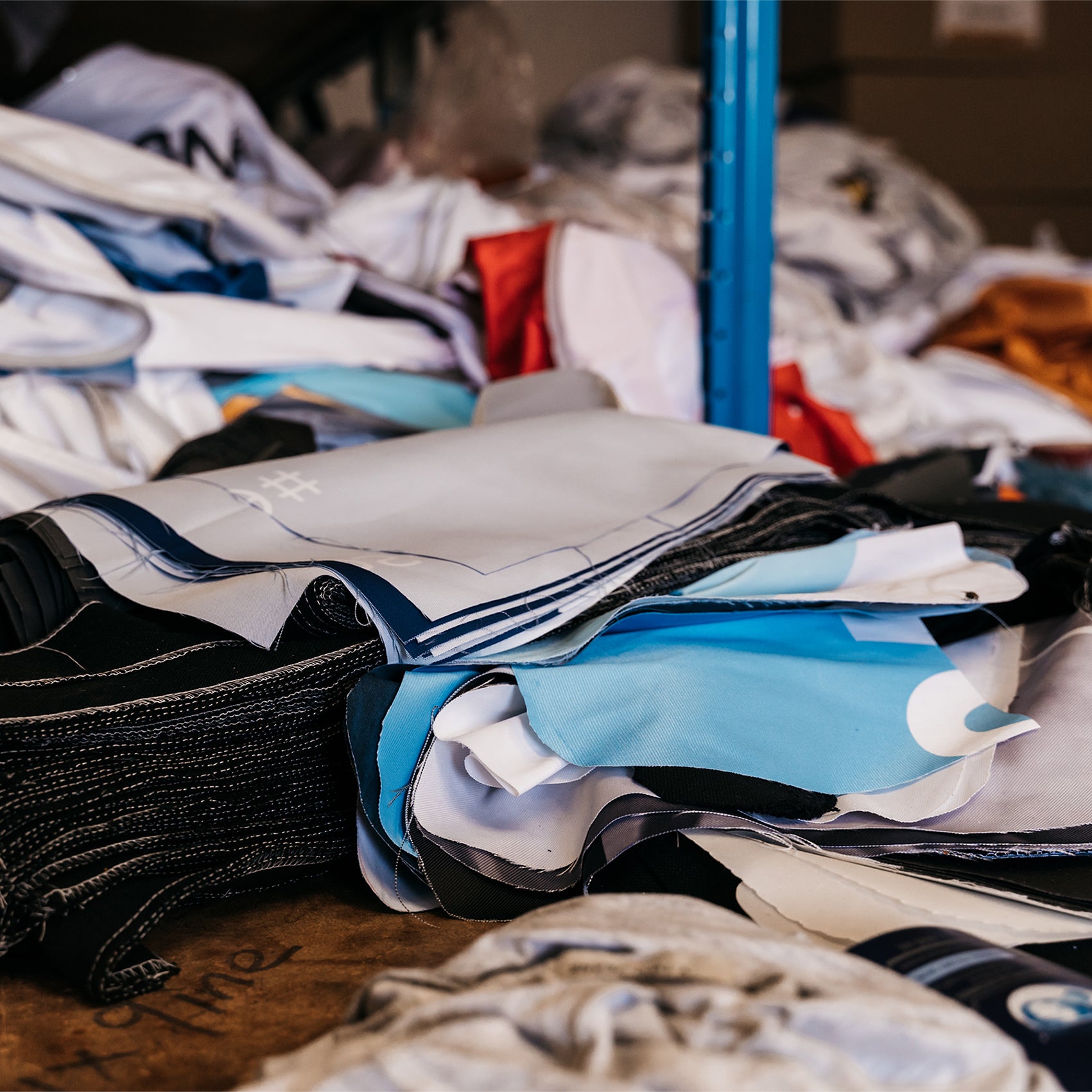Written by Alex Eales | Photos taken by Jasper Eales
For many, ‘babymoon’ spells an indulgent experience including pampering, spa treatments, energy balancing couples massage, ice cream on tap, room service dinner, breakfast in bed and a shopping spree for baby gear. Conversely, we bond best when we simplify and immerse ourselves in nature. So what better way to slow down and regroup in order to embrace the changes happening in our life, than to pack the Troopy and hit the road?

The road took us due north kicking off the trip with what drew us together in the first place – gliding along wave faces as the ocean crashes along our western shores. This would be the last session for me until I’m no longer a 2-in-1. We continued along this path to the coastal region of the Namaqua National Park – a land of striking contrasts where harsh climate has meant that flora and fauna have had to adapt or die. This would be the tune of the environment for the remainder of the trip as we were whipped by cold Atlantic gusts, blasted by dust and sand and scorched by the African sun. However, it is incredible to witness the forms that have been sculpted and life that has been shaped by these climes.
Whilst for most of the year Namaqualand is a brown and khaki coloured semi-desert, July to September sees a burst of colour after the winter rains resulting in millions of flowers that transform the landscape into a colourful tapestry. Pink flamingos wading through salty estuaries add to this colour burst. Interestingly, Namaqualand not only has some of the richest bulb flora of any arid region in the world, but more than a 1000 of its approximate 3500 plant species are not found anywhere else on Earth.

Delwerskamp is perched on a compacted shell bank above rocky gullies, inviting one to roll out of bed with the pink sunrise, straight into the crisp ocean. The coastal road is a single sand-track hugging bay after untouched bay. Corrugations make progress slow, which is fine when the windows are down and one is scouting potential wave set-ups, tortoises, snakes and florals. As a TripAdvisor review put it succinctly, “Best enjoyed with a 4x4 vehicle”. The Bitter river dune field stretches about 20km and is dubbed ‘the only unspoilt and properly functioning system left on the South African coast’. The white sand is fine and easily windswept, moving 5-10m northwards every year; exposing new areas where Stone Age fossils can be found. We succumbed to the persistence of this prevalent north advancing wind at Boulder bay; making full use of the purpose built stonewalls. Braving the elements for a sunset salute along the beautiful stretch of beach, the crunch of large shells underfoot is a sure sign of the abundance that lives between the boulders under the kelp beds.
One of the great awes of over landing is experiencing the landscapes change along with the vegetation and life that goes with it. From Hondeklip bay the succulents and sand give way to redder soils, granite outcrops littered with streaks of white sparkly quartz and quiver trees as one heads towards Springbok. This transition is palpable when looking down across ancient termite mines from the top of Wildeperdehoek pass (‘Wild horse corner/basin’).
Hearing parting advise from farewell-wishers, it seemed foolish to continue any further without at least one extra spare tyre. Springbok, a town nestled within a massive granite outcrop, got us stocked up, fueled up and with an extra spring in our step we were back on the road – to nothingness. Heading back to the coast from Springbok, the rocks crumble, shrubs diminish in size until they disappear completely and white sand prevails once more. The only landmarks towards Alexander Bay are mine heaps – a stark realization of how crude and crass human activity can be.
Following the oasis of the Orange River from Alexander bay inland, the formidable dark mountains of the ancient Richtersveld start piercing through the sand dunes. After a long day of driving we chased the last rays of sun into the park – a feat on rocky winding single-track roads where 40km takes 3 hours at best. Tracks such as Akkedis pass have been named intending to mimic and describe to sporadic movement of a lizard across hot rocks. Needless to say, the Troopy had a dream day.
Like an evil old witch, the Richtersveld lured us in to a balmy sunset as we dipped into the cool fresh river and dried off by a warm gentle draft surrounded by mountains glowing gold. Swapping the sound of the ocean with the river running by and puffy jackets with a summer dress, we settled alongside our braai under a clear sky with shooting stars streaking overhead. It seems she awoke on the wrong side of the bed and wanted us out in a cloud of dust. Having been around for between 500 million and 1 billion years with extreme winds, volcanic activity, dust storms and summer air temperatures reaching 60’C - this rocky, horny, thorny, scantly vegetated old duck is a force to be reckoned with. Fortunately we were able to stick out the mood in the safety of the Troopy while exploring the incredible 4x4 trails on offer, and discovered a protected swimming hole where we basked for the afternoon. The wind died down as the afternoon progressed, settling the dust to reveal spectacular evening hues and fireflies lighting up the riverside scene upon darkness.
 We wound back out of the park by the rose gold light of sunrise, to realize the wrath of the previous days’ sand storm at the Pont crossing over to Namibia. Note to self; when travelling in Africa always carry some cash, as the high winds had taken out all forms of communication and networks. R1000 got just enough fuel in the Troopy to get to the next available fuel stop, border crossing and road tax and off we trundled along the other side of the Orange River now. The morning was spent cutting off between the reeds to plunge into the refreshing river to escape the scorch, knowing we would be heading north into the desert soon.
We wound back out of the park by the rose gold light of sunrise, to realize the wrath of the previous days’ sand storm at the Pont crossing over to Namibia. Note to self; when travelling in Africa always carry some cash, as the high winds had taken out all forms of communication and networks. R1000 got just enough fuel in the Troopy to get to the next available fuel stop, border crossing and road tax and off we trundled along the other side of the Orange River now. The morning was spent cutting off between the reeds to plunge into the refreshing river to escape the scorch, knowing we would be heading north into the desert soon.
 Leaving the cool oasis of the river behind at Aussenkehr, which is nothing less than a green table grape-growing miracle, we headed across the lunar-like desert on gravel roads fit to land a Boeing. For a 160 kilometre-long chasm, the Fish River Canyon is surprisingly inaccessible. If you’re driving to this must-see Southern African wonder, the routes are fairly limited. In part, this is because of the difficult terrain. The |Ai-|Ais/Richtersveld Transfrontier National Park – through which the canyon cuts – is remote, dry and sparsely populated. On top of this, the park is a UNESCO World Heritage Site and is biologically diverse and extremely sensitive, thus the lack of public roads helps protect the area. It seems the best way to get immersed in the world’s second biggest canyon is by a grueling 5-day hike from north to south – but it is hot! Being ‘babymooners’, we opted for an overnight basking in the natural thermal baths at Ai-Ais, meaning ‘burning water’ in the local Nama language, at the southern end of the canyon. The resort sits inside the canyon walls, but the spectacular rim-top views dropping down hundreds of meters forming various layers via tectonic movement and erosion came for breakfast the next day at Hobas in the north. Unfortunately Hobas campsite has been badly damaged by an unimaginable recent flood, however, the Canyon Roadhouse, 16km north, with its classic cars rusting peacefully beneath quiver tree-lined ‘koppies’, fuel, Wi-Fi, but more importantly good coffee, hot meals, cold drinks and a pink sunset was a welcome western-style stop-over.
Leaving the cool oasis of the river behind at Aussenkehr, which is nothing less than a green table grape-growing miracle, we headed across the lunar-like desert on gravel roads fit to land a Boeing. For a 160 kilometre-long chasm, the Fish River Canyon is surprisingly inaccessible. If you’re driving to this must-see Southern African wonder, the routes are fairly limited. In part, this is because of the difficult terrain. The |Ai-|Ais/Richtersveld Transfrontier National Park – through which the canyon cuts – is remote, dry and sparsely populated. On top of this, the park is a UNESCO World Heritage Site and is biologically diverse and extremely sensitive, thus the lack of public roads helps protect the area. It seems the best way to get immersed in the world’s second biggest canyon is by a grueling 5-day hike from north to south – but it is hot! Being ‘babymooners’, we opted for an overnight basking in the natural thermal baths at Ai-Ais, meaning ‘burning water’ in the local Nama language, at the southern end of the canyon. The resort sits inside the canyon walls, but the spectacular rim-top views dropping down hundreds of meters forming various layers via tectonic movement and erosion came for breakfast the next day at Hobas in the north. Unfortunately Hobas campsite has been badly damaged by an unimaginable recent flood, however, the Canyon Roadhouse, 16km north, with its classic cars rusting peacefully beneath quiver tree-lined ‘koppies’, fuel, Wi-Fi, but more importantly good coffee, hot meals, cold drinks and a pink sunset was a welcome western-style stop-over.

The Kgalagadi Transfrontier Park (KTP), one of the largest national parks in the world, is the core of the arid Kalahari. Its size and pristine nature provide the opportunity for natural processes to continue with relatively little human disturbance in an ever increasingly human-dominated planet. It is indeed a biodiversity icon. The Kalahari is a land of huge vistas, climatic extremes and fascinating adaptations to harsh conditions. The infamous red sands originated from rocks lying within an immense basin formed in the southwest of this region. Over millions of years, before the continents began to drift apart, the rocks were eroded to fill the basin with fine sand. In the most arid southern regions, the minute sand grains are covered with ferric iron oxide and the prevailing low rainfall has preserved the astonishing variety of desert sand colours – from vivid orange-reds to burnt amber, brown ochre to smoky pink. With the addition of moisture, iron oxide is reduced to white ferrous oxide, so as one moves east up the rainfall gradient into Botswana, the colour of the sand changes to a yellow-white hue. There is no permanent naturally occurring water in the arid Kalahari and with summer highs of over 40’C and winter lows reaching bone-chilling -10’C, there are relatively few human inhabitants, and hence the vast tracts of land are unspoilt. This is particularly evident north of Nossob towards Union’s End, where unfenced wilderness camps are the only accommodation.
With the rains concentrating water down the two rivers in the park, the Nossob and Auob, and subsequent borehole waterholes situated in these areas, the herbivores move into the riverbeds: springbok, hartebeest, wildebeest, eland and gemsbok; naturally followed by the predators and scavengers: leopard, cheetah, lion, caracal, honey badger, hyena (spotted and brown types) and jackal. The valleys are thus a hive of activity and despite the vast landscape; game sightings of all shapes and sizes are abundant. Sitting and waiting at a windmill is a good strategy to view birds and small mammals such as caracal hunting sandgrouse and doves, and jackal on the hunt for any left-overs. We observed many springbok and gemsbok drinking, stomping and licking the accumulated salts off the soil. However, because of the animals of the Kalahari’s habit of moving large distances and their ability to survive without water, driving slowly along the riverbeds scanning for animals also proved very rewarding. Most predators are nocturnal so the best time to look for them is early morning and late afternoon. During these times, paying attention to the behavior of antelope – buck standing still and looking intently in one direction – often lead us to lion and cheetah. Unfortunately, leopard and African wildcat remained elusive.
 The perfect end to the trip took us via the untouched back-end of the Cederberg, through Botterkloof pass and Agter-pakhuis, beckoned by a home cooked farm meal by excited grandparents-to-be. The weekend comprised of a serendipitous gathering on the coast where we left off for a friend’s birthday, where I could show off my now faster swelling belly with pride.
The perfect end to the trip took us via the untouched back-end of the Cederberg, through Botterkloof pass and Agter-pakhuis, beckoned by a home cooked farm meal by excited grandparents-to-be. The weekend comprised of a serendipitous gathering on the coast where we left off for a friend’s birthday, where I could show off my now faster swelling belly with pride.
We indulged in sprawling untouched landscapes, the open road, being exposed to nature’s superpowers, many dinners (braai) under the stars, shooting stars, comets, waking up with the sun, wild animals and fire flies. Baby, your car seat is waiting and we can’t wait for you to join us!
 Lessons from nature, for our unborn child:
Lessons from nature, for our unborn child:
- Patience.
- Adapt to the changing environment - take the time to learn, read, think, and then acting comes instinctively.
- Play to your strengths.
- The Circle of life exists and everyone and thing plays a role.
- Everyone has a threat/weakness.
- Be alert and aware, but not stressed.
- Don’t give too much time to reflection, move forwards and onwards.
- Failure is part of every day, just try again.
- Take a nap in the shade of a tree; you’ll be better off for it.






